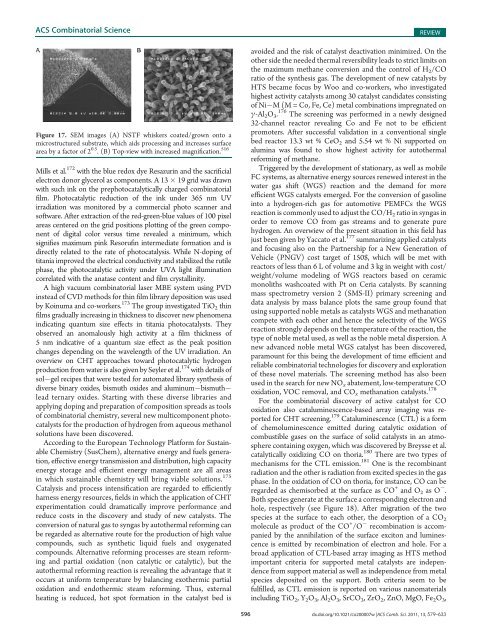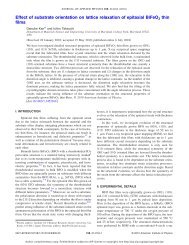Combinatorial and High-Throughput Screening of Materials ...
Combinatorial and High-Throughput Screening of Materials ...
Combinatorial and High-Throughput Screening of Materials ...
Create successful ePaper yourself
Turn your PDF publications into a flip-book with our unique Google optimized e-Paper software.
ACS <strong>Combinatorial</strong> Science<br />
Figure 17. SEM images (A) NSTF whiskers coated/grown onto a<br />
microstructured substrate, which aids processing <strong>and</strong> increases surface<br />
area by a factor <strong>of</strong> 2 0.5 . (B) Top-view with increased magnification. 516<br />
Mills et al. 172 with the blue redox dye Resazurin <strong>and</strong> the sacrificial<br />
electron donor glycerol as components. A 13 19 grid was drawn<br />
with such ink on the prephotocatalytically charged combinatorial<br />
film. Photocatalytic reduction <strong>of</strong> the ink under 365 nm UV<br />
irradiation was monitored by a commercial photo scanner <strong>and</strong><br />
s<strong>of</strong>tware. After extraction <strong>of</strong> the red-green-blue values <strong>of</strong> 100 pixel<br />
areas centered on the grid positions plotting <strong>of</strong> the green component<br />
<strong>of</strong> digital color versus time revealed a minimum, which<br />
signifies maximum pink Resorufin intermediate formation <strong>and</strong> is<br />
directly related to the rate <strong>of</strong> photocatalysis. While N-doping <strong>of</strong><br />
titania improved the electrical conductivity <strong>and</strong> stabilized the rutile<br />
phase, the photocatalytic activity under UVA light illumination<br />
correlated with the anatase content <strong>and</strong> film crystallinity.<br />
A high vacuum combinatorial laser MBE system using PVD<br />
instead <strong>of</strong> CVD methods for thin film library deposition was used<br />
by Koinuma <strong>and</strong> co-workers. 173 The group investigated TiO 2 thin<br />
films gradually increasing in thickness to discover new phenomena<br />
indicating quantum size effects in titania photocatalysts. They<br />
observed an anomalously high activity at a film thickness <strong>of</strong><br />
5 nm indicative <strong>of</strong> a quantum size effect as the peak position<br />
changes depending on the wavelength <strong>of</strong> the UV irradiation. An<br />
overview on CHT approaches toward photocatalytic hydrogen<br />
production from water is also given by Seyler et al. 174 with details <strong>of</strong><br />
sol gel recipes that were tested for automated library synthesis <strong>of</strong><br />
diverse binary oxides, bismuth oxides <strong>and</strong> aluminum bismuth<br />
lead ternary oxides. Starting with these diverse libraries <strong>and</strong><br />
applying doping <strong>and</strong> preparation <strong>of</strong> composition spreads as tools<br />
<strong>of</strong> combinatorial chemistry, several new multicomponent photocatalysts<br />
for the production <strong>of</strong> hydrogen from aqueous methanol<br />
solutions have been discovered.<br />
According to the European Technology Platform for Sustainable<br />
Chemistry (SusChem), alternative energy <strong>and</strong> fuels generation,<br />
effective energy transmission <strong>and</strong> distribution, high capacity<br />
energy storage <strong>and</strong> efficient energy management are all areas<br />
in which sustainable chemistry will bring viable solutions. 175<br />
Catalysis <strong>and</strong> process intensification are regarded to efficiently<br />
harness energy resources, fields in which the application <strong>of</strong> CHT<br />
experimentation could dramatically improve performance <strong>and</strong><br />
reduce costs in the discovery <strong>and</strong> study <strong>of</strong> new catalysts. The<br />
conversion <strong>of</strong> natural gas to syngas by autothermal reforming can<br />
be regarded as alternative route for the production <strong>of</strong> high value<br />
compounds, such as synthetic liquid fuels <strong>and</strong> oxygenated<br />
compounds. Alternative reforming processes are steam reforming<br />
<strong>and</strong> partial oxidation (non catalytic or catalytic), but the<br />
autothermal reforming reaction is revealing the advantage that it<br />
occurs at uniform temperature by balancing exothermic partial<br />
oxidation <strong>and</strong> endothermic steam reforming. Thus, external<br />
heating is reduced, hot spot formation in the catalyst bed is<br />
REVIEW<br />
avoided <strong>and</strong> the risk <strong>of</strong> catalyst deactivation minimized. On the<br />
other side the needed thermal reversibility leads to strict limits on<br />
the maximum methane conversion <strong>and</strong> the control <strong>of</strong> H 2 /CO<br />
ratio <strong>of</strong> the synthesis gas. The development <strong>of</strong> new catalysts by<br />
HTS became focus by Woo <strong>and</strong> co-workers, who investigated<br />
highest activity catalysts among 30 catalyst c<strong>and</strong>idates consisting<br />
<strong>of</strong> Ni M (M = Co, Fe, Ce) metal combinations impregnated on<br />
γ-Al 2 O 3 . 176 The screening was performed in a newly designed<br />
32-channel reactor revealing Co <strong>and</strong> Fe not to be efficient<br />
promoters. After successful validation in a conventional single<br />
bed reactor 13.3 wt % CeO 2 <strong>and</strong> 5.54 wt % Ni supported on<br />
alumina was found to show highest activity for autothermal<br />
reforming <strong>of</strong> methane.<br />
Triggered by the development <strong>of</strong> stationary, as well as mobile<br />
FC systems, as alternative energy sources renewed interest in the<br />
water gas shift (WGS) reaction <strong>and</strong> the dem<strong>and</strong> for more<br />
efficient WGS catalysts emerged. For the conversion <strong>of</strong> gasoline<br />
into a hydrogen-rich gas for automotive PEMFCs the WGS<br />
reaction is commonly used to adjust the CO/H 2 ratio in syngas in<br />
order to remove CO from gas streams <strong>and</strong> to generate pure<br />
hydrogen. An overwiew <strong>of</strong> the present situation in this field has<br />
just been given by Yaccato et al. 177 summarizing applied catalysts<br />
<strong>and</strong> focusing also on the Partnership for a New Generation <strong>of</strong><br />
Vehicle (PNGV) cost target <strong>of</strong> 150$, which will be met with<br />
reactors <strong>of</strong> less than 6 L <strong>of</strong> volume <strong>and</strong> 3 kg in weight with cost/<br />
weight/volume modeling <strong>of</strong> WGS reactors based on ceramic<br />
monoliths washcoated with Pt on Ceria catalysts. By scanning<br />
mass spectrometry version 2 (SMS-II) primary screening <strong>and</strong><br />
data analysis by mass balance plots the same group found that<br />
using supported noble metals as catalysts WGS <strong>and</strong> methanation<br />
compete with each other <strong>and</strong> hence the selectivity <strong>of</strong> the WGS<br />
reaction strongly depends on the temperature <strong>of</strong> the reaction, the<br />
type <strong>of</strong> noble metal used, as well as the noble metal dispersion. A<br />
new advanced noble metal WGS catalyst has been discovered,<br />
paramount for this being the development <strong>of</strong> time efficient <strong>and</strong><br />
reliable combinatorial technologies for discovery <strong>and</strong> exploration<br />
<strong>of</strong> these novel materials. The screening method has also been<br />
used in the search for new NO x abatement, low-temperature CO<br />
oxidation, VOC removal, <strong>and</strong> CO x methanation catalysts. 178<br />
For the combinatorial discovery <strong>of</strong> active catalyst for CO<br />
oxidation also cataluminescence-based array imaging was reported<br />
for CHT screening. 179 Cataluminescence (CTL) is a form<br />
<strong>of</strong> chemoluminescence emitted during catalytic oxidation <strong>of</strong><br />
combustible gases on the surface <strong>of</strong> solid catalysts in an atmosphere<br />
containing oxygen, which was discovered by Breysse et al.<br />
catalytically oxidizing CO on thoria. 180 There are two types <strong>of</strong><br />
mechanisms for the CTL emission. 181 One is the recombinant<br />
radiation <strong>and</strong> the other is radiation from excited species in the gas<br />
phase. In the oxidation <strong>of</strong> CO on thoria, for instance, CO can be<br />
regarded as chemisorbed at the surface as CO + <strong>and</strong> O 2 as O .<br />
Both species generate at the surface a corresponding electron <strong>and</strong><br />
hole, respectively (see Figure 18). After migration <strong>of</strong> the two<br />
species at the surface to each other, the desorption <strong>of</strong> a CO 2<br />
molecule as product <strong>of</strong> the CO + /O recombination is accompanied<br />
by the annihilation <strong>of</strong> the surface exciton <strong>and</strong> luminescence<br />
is emitted by recombination <strong>of</strong> electron <strong>and</strong> hole. For a<br />
broad application <strong>of</strong> CTL-based array imaging as HTS method<br />
important criteria for supported metal catalysts are independence<br />
from support material as well as independence from metal<br />
species deposited on the support. Both criteria seem to be<br />
fulfilled, as CTL emission is reported on various nanomaterials<br />
including TiO 2 ,Y 2 O 3 ,Al 2 O 3 , SrCO 3 , ZrO 2 , ZnO, MgO, Fe 2 O 3 ,<br />
596 dx.doi.org/10.1021/co200007w |ACS Comb. Sci. 2011, 13, 579–633












